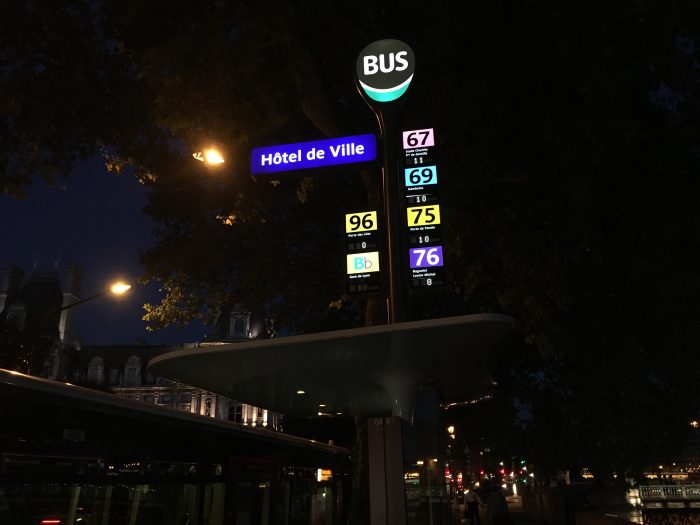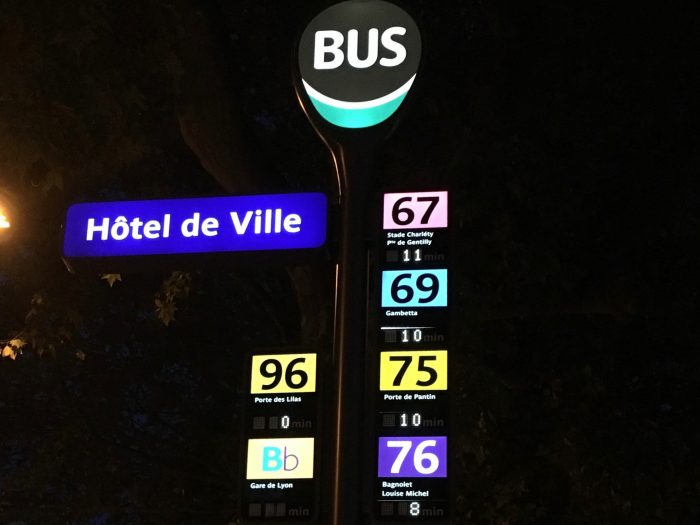Do you think bus service is never as “permanent” as rail service? Well, it depends on how much infrastructure you build, and how proudly it announces the bus service as an essential part of the cityscape, both as icon and as opportunity.
Each time I visit Paris there’s something new in its public transit, but these new bus stop signs, now standard across the city, are remarkable.

They’re around 4m (12 ft) high, towering over the bus shelter to which they’re attached. At night they are the most prominent informational icons in the streetscape, by an order of magnitude.
Look closer:

Every stop has a name, reaffirming your sense of your place in the city. (At night, these are actually the easiest locational signs to read, so they have navigational value extending beyond transit.) For each route, there’s the number, the endpoint (indicating direction of travel) and the number of minutes until the next bus arrives. If you know the network, you don’t even have to look down to know where you are, and when the next bus is coming.
Here’s one in the daytime, when the little realtime displays are harder to catch in a photo.

I don’t have a good pic of the entire shelter, but it has everything you’d expect of a rail stop, including maps of each route, a diagram of the bus network, a diagram of the metro and regional rail network, and timetable and fare information. It also has more extensive realtime information displays, showing the next several buses departing.
On the other hand, it doesn’t have the extraneous things that my architecture and built-environment friends often suggest, such as distinctive architectural designs or “community hub” features like coffee vending or (yes) lending libraries — all of which have been explored. A big city needs lots of bus stops, so the ideas that matter are the ones that scale. In any case, the more you respect your bus system, the more you can celebrate it for what it is, rather than expecting it to entertain us in ways that distract from the liberty it provides.
When I lived in Paris in 1986, the buses and bus shelters were like what most Americans are used to: basic, functional, but sometimes dirty and poorly maintained. It was presumed, back then, that the Metro and regional rail systems were the serious transit, and that the buses didn’t matter much, and the infrastructure reinforced that message.
All that has changed. Buses are so nice that you can scarcely distinguish them from trams (streetcars). Many streets have car-free lanes that buses can use. Now, with these pillars of information, bus stops are even easier to find than metro stations, and almost as easy to navigate.
There are several principles at work here:
- The more subways you have, the more surface transit you need. This excellent bus system operates right on top of the world’s densest metro network (in terms of stations/sq km). Almost everyone in Paris is near a metro station, but there are still plenty of markets (short trips, trips along paths not followed by metro) where surface transit is the right tool.
- Unless you already have streetcar tracks everywhere, the only surface transit that can cover your whole city, soon, is bus service.
- So if you want an effective transit system for everyone, you have to convey that the bus system matters, through network design, branding, and infrastructure.
- The order is important. First get the network design right, then develop branding that works with the network design. Finally, conceive infrastructure that serves and celebrates both.
I could quibble with Paris on that last point. As with most bus networks, Paris’s seems to be more complex than it needs to be, though a modest simplification is underway, as you can see by playing the map here* . The signage doesn’t help us distinguish major routes from minor ones. Imagine the extreme transparency that would arise from fusing Paris’s level of bus signage with Barcelona’s commitment to extreme simplicity and legibility in network design.
But the big point is this: Buses can be as liberating and efficient as your city wants them to be. The more efficient and liberating they are, the more they deserve to be celebrated in infrastructure. The bus stop is one of the biggest signals, to everyone in the city, about the community’s attitude toward buses and their customers.
* At this page, you can move the map left or right to see the changes. The current network is on the left, the proposed one on the right. It’s simpler but not that much simpler, and it still doesn’t help you distinguish major routes (high frequency, long duration) from minor ones (lower frequency, short duration).